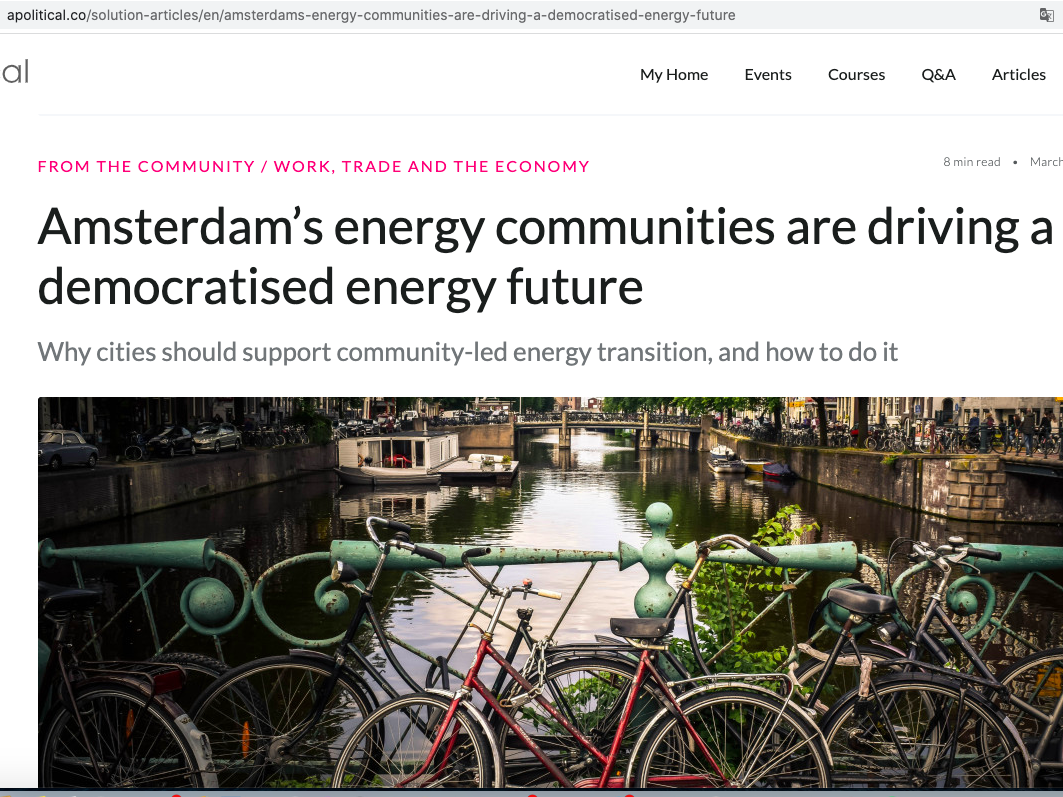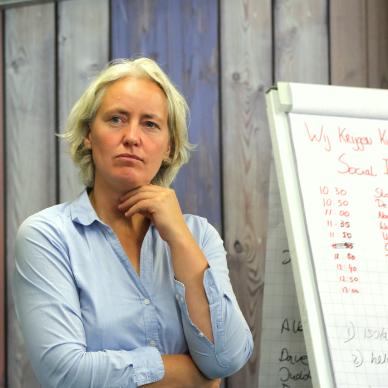Amsterdam’s energy communities are driving a democratised energy future

Voor de mensen die er niet inkomen via deze link https://apolitical.co/solution-articles/en/amsterdams-energy-communities-are-driving-a-democratised-energy-future :
Amsterdam’s energy communities are driving a democratised energy future
Why cities should support community-led energy transition, and how to do it
This post is written by Kate Goodwin, design & research specialist at Democratic Society, and Thomas de Groot, director of the Commons Network.
The problem: Amsterdam’s citizen-led energy initiatives have the drive and skills to bring about a decarbonised, distributive energy future benefiting the whole city, but are held back because of a lack of appropriate legal and financial options and regulatory frameworks recognising their different needs.
Why it matters: This is the time for Amsterdam - and other cities like it seeing a trend of civic initiatives - to cultivate communities with the right resources and support for the best chance of democratic, sustainable, locally-owned energy futures that benefit all.
The solution: Establish an energy commons to help energy communities flourish - here are six things cities can do.
Amsterdam’s energy system is transforming at the hands of its citizens. The city is committed to sustainable energy generation and reducing CO2 emissions by 55% in 2030 and 95% in 2050. Leading the charge are the city’s 30+ energy communities, citizens who have stepped in to reclaim the energy system, investing their skills and resources to produce, sell and manage renewables: wind, solar and district heating. This trend is happening across Europe, and sees a shift to shared ownership and social cohesion over market competition and profit-led growth. Public services are being reclaimed both from the public sector and the market. But communities lack appropriate resources, recognition and city support. This stifles the spread of community-led approaches, and therefore democratised energy production benefiting all.
This isn’t a problem for the city to address, it’s an opportunity: for shared ownership of energy resources and shared spaces for bottom-up, collective decision making and co-governance on energy production, that we can call ‘energy commons’. And importantly, it’s a way for cities to take ownership over energy production to safeguard against cross-border energy supply tensions. We see this energy commons as a way for Amsterdam – and cities like it – to step towards just, resilient, decarbonised climate futures, democratically.
Read on for six things cities can do for an ‘energy commons’ to flourish, based on our experience and work in Amsterdam.
What are ‘commons’?
We refer to commons when we talk about shared resources, like knowledge or energy, being governed democratically by a distinct group of people, according to clear rules and protocols. So a commons is a social system. But the commons also offers us a different way of looking at power structures and economic models. Why are certain markets organised the way they are, and why are people often only seen as consumers, and not as provisioning communities?
Political economist Elinor Ostrom is known for her academic efforts to disprove and debunk ‘the tragedy of the commons’, strongly believing in the bottom-up approach – that individual and community support was critical to any interventions being considered by governments.
While commons can be applied in all domains, this article frames them in the energy context.
Six things cities can do for an ‘energy commons’ to flourish
1. Set up an incubator for the energy commons
Community initiatives need a way to step away from small-scale subsidies, and into the real economy where they compete with commercial companies and public institutions – i.e. democratising the economy. An ‘incubator for the commons’ – something akin to an incubator for startups but with a focus on communities instead of commercial products – is being developed in Amsterdam by Commons Network, civil society organisations and communities of practice.
Examples of use cases include platform cooperatives to compete with Silicon Valley-inspired delivery services, offering an ‘exit to community’ to small and medium-sized businesses to turn them into worker-owned cooperatives, neighbourhood enterprises to revitalise the local democratic economy and of course energy communities. The commons incubator itself will also be governed as a public-civic partnership, with a big role for the municipality, and it will also serve as a knowledge hub and a research institute for public-civic partnerships.
Part of setting up an incubator for the commons is agreeing principles of who can join. These are proposed as:
Non-profit and purpose-driven;
Democratically owned and governed e.g. worker-owned cooperative;
Adding value to the locality and the community, both in their business and organisational models.
2. Seek city recognition and support of energy commons
Supporting ground-up structural and institutional innovation is what’s needed for the climate transition, and in the energy context, this means giving energy communities the resources and recognition to be able to do it. This includes establishing ecosystems like public-civic partnerships, which also provide risk capital and legal support. It also involves council and higher-level decision-maker support as a ‘commons city’, with new policy frameworks and policy tools supporting commons co-governance. Ghent, Belgium, is a world-leading example of bringing the commons to life, starting with a Commons Transition Plan in 2017, which has shaped legal and management strategies and boosted cooperation between the City of Ghent and community-led initiatives.
3. Create an experimentation zone
Dedicating an entire region of the city as a playing field for energy communities, supported with enough resources but with relaxed rules - a ‘policy-free’ zone - encourages innovation, expands participation opportunities, and gives energy communities room to experiment with new tools and models of governance on themes such as shared ownership. An example is Amsterdam’s Osdorpplein freezone. Such an environment would cultivate conditions to empower energy communities, build upon opportunities, re-build the social fabric, and deliver new knowledge and innovation for the people around it.
4. Get legal recognition
Legal entities are things that commons struggle with. For example in Amsterdam, energy communities are currently classed as social enterprises, but not recognised as legal entities, so cannot register for social impact purposes. A current option is for energy communities to be recognised as a B-Corp: part of a social enterprise, part of a community. In 2023 the Netherlands is due to introduce legislation to recognise social enterprises as legal entities.
5. Research financial autonomy and innovative funding options
Energy communities need financial autonomy to function. In Amsterdam there are no financial options suited to communities, so to compete for bids - often of 1 million Euro minimum entry - they are required to band together in complex, high-risk lending arrangements. Bids processes therefore favour traditional market competitors and keep energy communities out. Financing options suited to the energy commons include:
Revolving funds, where an internal capital pool serves funding of renewable energy projects that generate cost savings;
Environmental impact bonds that raise capital on environmental projects and repay the principal and interest from the financial benefits resulting from the environmental benefits of the project;
Campaigns for transvestment, where value is transferred from the market to the commons;
A guide showing where energy communities can look for capital by stage of business development, similar to this Access to capital map for enterprises.
6. Foster expanded participation
Expanded participation helps institutionalise participation and foster conditions for commons co-governance. This means bringing diverse actors together for bottom-up planning and decision making in the experimentation zone, involving citizens from diverse neighbourhoods, not just ‘frontrunners’ who are better connected with city officials due to class or privilege. Both the city and existing energy communities have a role in addressing this to realise the democratic intentions of the commons, by first acknowledging the absence of diverse communities from participation processes, and then finding ways to include them. Participation and deep collaboration cultivates relationships, networks and trust. Collectively these things form the foundations for sustainable energy futures grounded in democratic, relational ways.
Amsterdam’s citizens are steering the city’s energy future, a trend increasingly being witnessed in European cities. The opportunity is for the city and others like it to recognise and set conditions for these communities to flourish via an ‘energy commons’. Features of an energy commons would include incubators and public-civic partnerships for networking, capability building, knowledge sharing and legal support, experimentation zones for establishing new forms of governance from the ground up, innovative funding options, and policy frameworks recognising the different needs of community-led initiatives.
Serving energy communities serves the city itself, as a significant step towards democratic, sustainable, locally-owned energy futures.
With thanks to EIT Climate-KIC, City of Amsterdam and Amsterdam’s energy communities for the opportunity to engage in and share this work.
